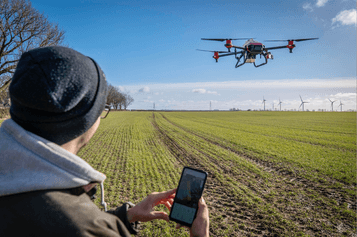Please provide the date or text you’d like me to rewrite in day month year format, and I’ll be happy to assist!
Historic Authorization for Agricultural Drones in the UK
In a groundbreaking move for the agricultural sector, XAG’s innovative agricultural drones, the P40 and V40, have received the first Operational Authorization for spraying operations from the UK’s Civil Aviation Authority (CAA). This landmark decision, made possible through the collaboration with AutoSpray Systems, heralds a new era for smart farming in the region, promoting automation and artificial intelligence as critical tools in achieving the net-zero carbon goals of British agriculture.

Using Smartphone to Control Drone
The Rise of Drones in Agriculture
The use of drone technology has been steadily rising across various sectors, yet agriculture has emerged as one of its most promising applications. Until recently, drone operations in the UK faced stringent regulations from the CAA, including restrictions on takeoff weight and material drops, effectively grounding many innovative solutions that farmers sought.
However, the release of the UK Government’s ambition statement and its vision for commercial drones sparked a re-evaluation. The CAA began to consider granting Operational Authorization for heavier drones, allowing XAG’s autonomous systems to spray and spread materials with pinpoint accuracy, boosting productivity while adhering to safety standards.
Future Forecasts and Economic Impact
According to forecasts by PwC, by the year 2030, the commercial drone sector in the UK could see up to 900,000 drones in operation, potentially creating 650,000 jobs and contributing £45 billion to the national economy. Furthermore, this expansion is expected to save businesses £22 billion while reducing carbon emissions by an impressive 2.4 million tons, thus transforming the rural economy and promoting sustainability.

XAG Drone in Greenhouse Shading Operation
Environmentally Friendly Farming Solutions
Data from the Department for Environment, Food and Rural Affairs indicate that agricultural activities occupy around 71% of the UK’s total land area, intensifying environmental pressures. To encourage eco-friendly practices, the government is launching Sustainable Farming Incentives, which will pay farmers up to £40 per hectare for initiatives aimed at improving soil health and mitigating climate change impact.
Electric XAG agricultural drones emerge as a solution, powered by batteries that significantly reduce reliance on diesel fuel, thereby decreasing greenhouse gas emissions. These drones are engineered for precision, employing RTK centimeter-level navigation technology to minimize chemical usage while protecting soil integrity. Key functions of these drones include plant protection spraying, fertilizer spreading, and greenhouse shading.

Pilot Swapping Battery for Drone
Innovating Beyond Traditional Farming
Traditionally, UK farmers have relied on heavy tractors and self-propelled sprayers for crop management. However, the high costs and limitations posed by the UK’s wet climate and mountainous terrain have made this approach less viable. Autonomous drones provide an efficient alternative that can easily access difficult terrains without causing soil compaction or damage.
Since collaborating with Harper Adams University on research related to precision agriculture in 2018, XAG has tirelessly worked to tap into the UK drone market. The granting of Operational Authorization is set to be a game-changer, officially welcoming agricultural drones into the British farming landscape.


